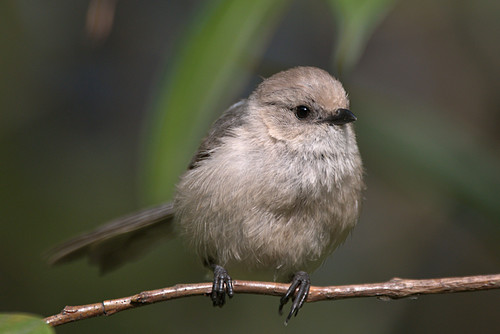
Bushtit
The Bushtit (*Psaltriparus minimus*) is a tiny, active songbird native to North America. It is known for its highly social behavior, often foraging in flocks and constructing elaborate, pendulous nests. These birds play a crucial role in controlling insect populations within their ecosystems. While not particularly flashy in appearance, their constant movement and chattering calls make them a lively presence in oak woodlands, chaparral, and even suburban gardens. Bushtits do not hold any prominent cultural significance, but they are well-loved by birdwatchers for their energetic nature.
7-9 cm
Length
11-14 cm
Wingspan
Least Concern
Conservation Status
Distribution
Bushtits are found throughout western North America, ranging from southwestern British Columbia south through the western United States and into Mexico, extending as far south as Guatemala. They are primarily resident birds, though some populations at higher elevations or in colder regions may undertake short-distance altitudinal migrations.
Lifespan
Average lifespan in the wild is 2-3 years, but some individuals can live up to 7 years.
Bushtit's Habitat
Habitat Types
Oak woodlands, Chaparral, Mixed coniferous forests, Riparian areas, Suburban gardens and parks
Climate Zones
Temperate, Subtropical, Mediterranean
Adaptations
Bushtits are highly adaptable to a variety of habitats, thriving in both wild and human-altered landscapes. Their small size and agility allow them to forage effectively in dense vegetation. Their social behavior provides advantages in finding food and detecting predators.
Variations
Several subspecies of Bushtit are recognized, differing slightly in plumage coloration and size. Coastal populations tend to be darker, while interior populations are paler. The "Black-eared" Bushtit, found in parts of the southwestern US and Mexico, exhibits a distinctive black ear patch in males.
Appearance
Breeding Plumage
Plumage remains relatively consistent throughout the year.
Seasonal Feather Changes
None
Sex Based Plumage Differences
Generally subtle. Some subspecies show differences in head coloration; for example, male 'Black-eared' Bushtits have black ear patches, while females have gray ear patches. Eye color can also differ between sexes in some populations.
Notable Features
Long tail relative to body size, Small, stubby bill, Gray-brown overall plumage, Round body shape
Diet and Feeding
Primary Foods
Small insects, Spiders, Insect eggs and larvae, Some seeds and berries (especially in winter)
Foraging Behavior
Bushtits are active foragers, gleaning insects and spiders from leaves and branches. They often hang upside down while searching for food. They forage in flocks, moving quickly through the vegetation.
Specializations
Their small size and agility allow them to access insects in tight spaces that larger birds cannot reach. Their flocking behavior may help them flush out prey.
Seasonal Diet Variations
While primarily insectivorous, Bushtits will consume more seeds and berries during the winter months when insect availability is reduced.
Behavior
Social Structure
Highly social birds, usually found in flocks of 10-40 individuals outside of the breeding season. These flocks maintain a loose social hierarchy.
Communication
Constant, high-pitched 'tsip' and 'pit' calls, Chattering and twittering sounds, Contact calls maintain flock cohesion
Migration
Most populations are non-migratory, but some may undertake short-distance altitudinal movements in response to weather conditions.
Territorial or Group Behaviors
During the breeding season, pairs or small family groups will defend a nesting territory. Outside of the breeding season, flocks roam more widely.
Conservation
Threats
Habitat loss and fragmentation due to urbanization and agriculture, Pesticide use, which reduces insect prey, Climate change, potentially affecting habitat suitability and insect availability
Protection Programs
General habitat conservation efforts benefit Bushtits, No specific, large-scale protection programs are currently in place
Local National Laws
Protected under the Migratory Bird Treaty Act in the United States.
Population Trend
Stable
Population Estimates
Global population estimated to be around 14 million individuals.
Interesting Facts
Bushtits build incredibly intricate nests.
These nests can be up to a foot long and are woven together with spider silk and plant fibers, providing excellent insulation and camouflage.
They are one of the smallest passerines in North America.
Their tiny size allows them to exploit food resources that larger birds might overlook.
Bushtits often have helpers at the nest.
This cooperative breeding behavior increases the survival rate of the young.
Flocks of Bushtits huddle together at night to conserve heat.
This behavior, known as communal roosting, is particularly important during cold weather.
Faqs about Bushtit
What do Bushtits eat?
Bushtits primarily eat small insects and spiders, but they will also consume some seeds and berries, especially in winter.
Where do Bushtits live?
Bushtits are found in a variety of habitats, including oak woodlands, chaparral, and even suburban areas, throughout western North America.
Are Bushtits migratory?
Most Bushtits are resident birds, meaning they stay in the same area year-round. However, some populations may move to lower elevations in winter.
How can I attract Bushtits to my yard?
Provide dense shrubs and trees for foraging and nesting. Avoid using pesticides, which can harm their food supply. A water source, such as a bird bath, can also be attractive.
Copyright @ Nature Style Limited. All Rights Reserved.
 English
English